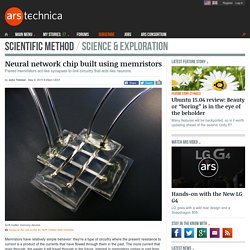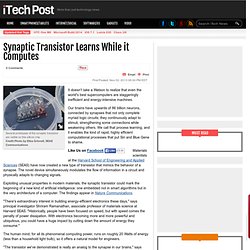

Wearing single-walled carbon nanotube electronics on your skin. Neural network chip built using memristors. Memristors have relatively simple behavior: they're a type of circuitry where the present resistance to current is a product of the currents that have flowed through them in the past.

The more current that goes through, the easier it will travel through in the future. Interest in memristors comes in part from the fact that the resistance persists even after current is turned off, making them a possible option for non-volatile memory. But the behavior of memristors is also fairly similar to that of a radically different type of circuitry: the synapses of neurons. Synapses are sites where nerve cells establish connections. The more signals that pass through these connections, the stronger the link between the two neurons becomes. New Accuracy Leap Could Speed Arrival of Superfast Quantum Computers. Research teams at the University of New South Wales claim to have developed two new types of “quantum bits” that process data with nearly 100 percent accuracy, addressing one of the key stumbling blocks in the promising realm of quantum computers.

These machines tap into the weird world of quantum mechanics to herald vast leaps in the capabilities of computer processing, as Re/code explored in a recent story. Traditional computers work with binary bits of information, 1s and 0s. But quantum computers rely on the odd physics that kick in at the atomic level, where objects can occupy more than one space at a time (superposition) and link across vast distances (entanglement).
A quantum computer’s quantum bits, or qubits, can be 1s and 0s simultaneously, and perform numerous operations on the same data at once. The two teams at UNSW jointly published their findings on Sunday in the journal Nature Nanotechnology. Doctors store 1,600 digital hearts for big data study. 14 February 2015Last updated at 23:10 ET By Pallab Ghosh Science correspondent, BBC News Never before has so much information been collected and storied on so many human hearts Doctors in London have stored 1,600 beating human hearts in digital form on a computer.

Scientists Discover "Reset Button" For The Body's Biological Clock. Jetting half way across the world, shift work and those crazy all-nighters are all things that can upset our body’s daily cycle, or circadian rhythm.

Over the years, scientists have slowly been piecing together the components of our “biological clocks” that drive these rhythms, and we now have a pretty good understanding of how they are coordinated. Now, scientists have discovered what is effectively a “reset button” in mice, which could eventually help researchers develop novel treatments that correct mismatches between the environment and our internal body clocks. Circadian rhythms are physiological, mental and behavioral changes that follow an approximately 24-hour cycle, which are primarily dictated by changes in light in the environment. It’s been known for some time that this “master clock” is a bundle of neurons in a region called the suprachaismatic nucleus (SCN); however, scientists didn’t know whether altering the way that these cells fire could change how it operates.
Molecular. Synaptic Transistor Learns While it Computes - Gadgets & Robots. Several prototypes of the synaptic transistor are visible on this silicon chip Credit:Photo by Eliza Grinnell, SEAS Communications It doesn't take a Watson to realize that even the world's best supercomputers are staggeringly inefficient and energy-intensive machines.

Our brains have upwards of 86 billion neurons, connected by synapses that not only complete myriad logic circuits; they continuously adapt to stimuli, strengthening some connections while weakening others. We call that process learning, and it enables the kind of rapid, highly efficient computational processes that put Siri and Blue Gene to shame. Like Us on Facebook Materials scientists at the Harvard School of Engineering and Applied Sciences (SEAS) have now created a new type of transistor that mimics the behavior of a synapse. "There's extraordinary interest in building energy-efficient electronics these days," says principal investigator Shriram Ramanathan, associate professor of materials science at Harvard SEAS. It won't. 11/03/13, 14:19: I've skipped over entertaining. Million-Year Data Storage Disk Unveiled. Back in 1956, IBM introduced the world’s first commercial computer capable of storing data on a magnetic disk drive.

The IBM 305 RAMAC used fifty 24-inch discs to store up to 5 MB, an impressive feat in those days. Today, however, it’s not difficult to find hard drives that can store 1 TB of data on a single 3.5-inch disk. But despite this huge increase in storage density and a similarly impressive improvement in power efficiency, one thing hasn’t changed. The lifetime over which data can be stored on magnetic discs is still about a decade. That raises an interesting problem. Today, we get an answer thanks to the work of Jeroen de Vries at the University of Twente in the Netherlands and a few pals. These guys start with some theory about ageing. This is based on the idea that data must be stored in an energy minimum that is separated from other minima by an energy barrier. It is fascinating concept that.